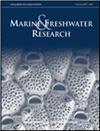不同类型湿地的范围、区域分布及面积变化
IF 1.5
4区 环境科学与生态学
Q2 FISHERIES
引用次数: 77
摘要
我们收集了全球和区域(拉姆萨尔区域)的现有数据和信息,以及22类海洋或沿海和内陆湿地的面积变化。从有资料分类来看,内陆天然表层湿地以非森林泥炭地、沼泽和冲积土沼泽为主,占地表湿地总面积的约77%,其中泥炭地占内陆天然湿地的约33%。较小面积的海洋或沿海湿地(约占湿地总面积的10%)主要为无植被的潮滩和盐沼。已知的人造湿地面积最大的是稻田和蓄水体,热带油棕和纸浆木种植园的面积要小得多。这些人造湿地的面积都在增加。据报道,全球自然湿地面积的减少发生在几乎所有类别的内陆和海洋或沿海自然湿地。根据这些湿地类别估算的全球湿地总面积介于15.2×106和16.2×106km2之间,与最近通过遥感估算的全球湿地面积类似。鉴于湿地种类面积的数据缺口相当大,即使是最近对全球湿地范围的其他估计也可能被低估。本文章由计算机程序翻译,如有差异,请以英文原文为准。
Extent, regional distribution and changes in area of different classes of wetland
We compiled available data and information on the global and regional areas (Ramsar regions), and changes in area, of 22 classes of marine or coastal and inland wetlands. From those classes for which there is information, inland natural surface wetlands (forming ~77% of total surface wetland extent) are dominated by non-forested peatlands, marshes and swamps on alluvial soils, with peatlands forming ~33% of natural inland wetlands. The smaller area of marine or coastal wetlands (~10% of total wetland extent) is dominated by unvegetated tidal flats and saltmarshes. Largest areas of human-made wetlands for which there is information are rice paddy and water storage bodies, with a much smaller area of tropical oil palm and pulpwood plantations. These human-made wetlands are all increasing in area. The reported decline in global natural wetland area is occurring across almost all classes of inland and marine or coastal natural wetlands. Total global wetland area estimated from these wetland classes is between 15.2×106 and 16.2×106km2, similar to recent global wetland area estimates derived from remote sensing. Given the considerable data gaps for area of wetland classes, even the most recent other estimates of global wetland extent are likely to be underestimates.
求助全文
通过发布文献求助,成功后即可免费获取论文全文。
去求助
来源期刊

Marine and Freshwater Research
环境科学-海洋学
CiteScore
4.60
自引率
5.60%
发文量
76
审稿时长
3.8 months
期刊介绍:
Marine and Freshwater Research is an international and interdisciplinary journal publishing contributions on all aquatic environments. The journal’s content addresses broad conceptual questions and investigations about the ecology and management of aquatic environments. Environments range from groundwaters, wetlands and streams to estuaries, rocky shores, reefs and the open ocean. Subject areas include, but are not limited to: aquatic ecosystem processes, such as nutrient cycling; biology; ecology; biogeochemistry; biogeography and phylogeography; hydrology; limnology; oceanography; toxicology; conservation and management; and ecosystem services. Contributions that are interdisciplinary and of wide interest and consider the social-ecological and institutional issues associated with managing marine and freshwater ecosystems are welcomed.
Marine and Freshwater Research is a valuable resource for researchers in industry and academia, resource managers, environmental consultants, students and amateurs who are interested in any aspect of the aquatic sciences.
Marine and Freshwater Research is published with the endorsement of the Commonwealth Scientific and Industrial Research Organisation (CSIRO) and the Australian Academy of Science.
 求助内容:
求助内容: 应助结果提醒方式:
应助结果提醒方式:


